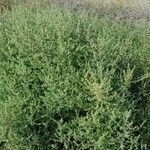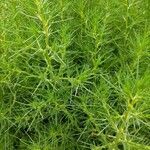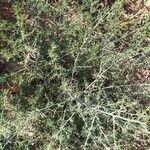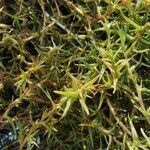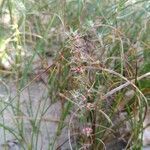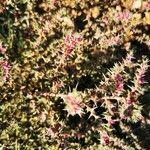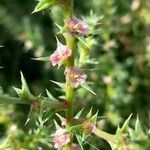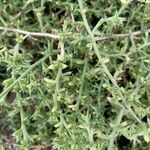Glabrous or hairy annual herb to c. 50 cm tall; stems decumbent or prostrate, shining, succulent, minutely puberulent or glabrous, pale-ridged; taproot stout. Lvs 0.3-2-(4) cm long, linear-subulate to subterete or narrow-triangular, succulent, shining, glabrous, or puberulent below, especially on the pale midrib; margin often ciliolate; apex spine-tipped. Bracteoles < lvs, triangular-ovate, often ciliolate, spine-tipped. Perianth (1.5)-2-3 mm long; segments unequal, ± ovate, acuminate, becoming firm, accrescent; wing variously ribbed, becoming fan-like and up to 2-(3) mm wide, with spiny middle nerve prolonged beyond membrane. Stigmas slender, exserted. Fr. surrounded by spiny bracteoles, with persistent style base. Seed 1-2.5 mm diam., dark.
Erect rounded annual to 60 cm high, succulent when fresh, glabrous or hispid, often verrucose, sometimes woolly in axils. Leaves linear-subulate, decurrent, 10–30 mm long, 2–3 mm wide, semiterete, broad and slightly clasping at base. Floral leaves and bracteoles similar to foliage leaves or much broader at base, equal to or exceeding flowers. Flowers in open or condensed spikes. Tepals 3–4 mm long, free, oblong, obtuse to acute, at first membranous but becoming cartilaginous, developing unequal obovate to reniform horizontal scarious wings 2–5 mm wide or these represented by pectinate protuberances. Utricle hemispherical, truncate above; pericarp crustaceous above otherwise membranous.
Annual, dwarf shrub, up to 0.3 m high; glabrous or with short bristles; not blackening when dried; leaves, bracts and prophylls linear-subulate, spiny at tip, pungent. Stems decumbent or ascending, becoming woody at base; hispid or glabrescent. Leaves sessile; lower ones opposite, upper ones alternate, herbaceous, succulent; blade decurrent, semiterete, linear-subulate, apex mucronate-spiny, base clasping. Flowers: 1-3 in an axil, forming loose and leafy spikes; bracteoles longer than perianth, oblong-ovate to triangular; perianth segments cartilaginous with scarious wings 2-5 mm wide; white; Oct.-May.
Chaffy-hispid (rarely glabrous), to 4 dm, with long, prostrate or ascending branches from the base; lvs rather firm, linear subulate, to 3 cm, 1–2 mm wide, reduced upwards and passing into the divergent, spinescent bracts; bracteoles spinescent, longer than the fl, deflexed in fr; sep stiff, with a distinct midvein shortly exserted as a subulate spine-tip, in fr wingless or with a deeply and irregularly cleft or pectinate wing, the whole 4–6(–7) mm wide; embryo closely coiled in several layers; 2n=36. Sea-beaches; Nf. to La., and on the coast of w. Europe.
Robust, much-branched, annual herb, 0.4-0.6 m high, glabrous, rounded, with strong tap roots; aerial portion tumbling in wind when dry. Leaves sessile, linear to deltoid, acuminate, spine-tipped. Flowers aggregated in a spiciform way towards ends of branchlets, subtended by 2 relatively large bracteoles, hermaphrodite. Sepals 5, developing a horizontally spreading wing in fruit. Stamens 5. Stigmas 2, spreading. Flowering time Sept.-Apr. Fruit a small, brownish capsule surrounded by 5 papery wings.
A rigid annual shrub. It is a succulent plant when young but becomes stiff and spiny. It grows 50 cm high. The leaves are small and fleshy. They are circular when cut cross wise and end in a point. They are 5-12 mm long by 2-3 mm wide. The flowers are very small and green. They are hidden in the axils of the leaves.
Herbaceous, annual shrublet, up to 300 mm tall. Leaves linear-subulate, decurrent, semiterete. Tepals cartilaginous with scarious wings 2-5 mm wide. Flowers white.
Glabrous, rounded annual to 50 cm. Leaves sessile, linear to deltoid, acuminate, spine-tipped. Flowers 1-few in axils, whitish, fruits with a papery wing.
